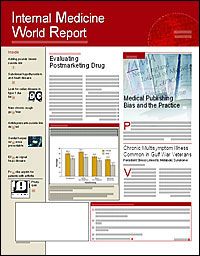Proposed Funding Changes Could Jeopardize HIV/AIDS Care
Since its inception in 1990, the Ryan White CARE (Comprehensive AIDS Resource Emergency) Act has provided federal funds for the treatment of the >500,000 low-income patients with HIV/AIDS in the United States.
The CARE Act, which distributes federal funds to states and cities for medical care, medication, and social services for patients with HIV/AIDS, expires every 5 years. It was renewed without major changes in 1995 and 2000. As it was approaching its renewal date in September 2005, the Bush administration submitted a set of CARE Act Reauthorization Principles that, if passed, could lead to a redistribution of funds. Congress is still considering the proposed changes; the CARE Act is under a 1-year temporary extension but has not yet been renewed. Given the potential impact of changes to this multibillion-dollar program, clinicians caring for patients with HIV/AIDS need to know how these changes could affect their practices and their patients.
The CARE Act consists of 4 sections:
? Title I provides funding for primary care to larger cities
? Title II provides funding for states and territories for primary care, including funding for the AIDS Drug Assistance Program (ADAP)
? Title III supports medical care and early intervention services for patients with HIV through community health centers
? Title IV supports service and research for women and children with HIV/AIDS and their families.
The new proposal could result in major changes in how funds are used without any increase in funding overall. One principle in the proposal requires that 75% of funds be used for core medical services so that, according to the Department of Health and Human Services (HHS) Web site, "Federal funds are first used to support life-saving services for the most impoverished Americans."
More than one half of CARE Act funds support primary health care services, or "core services," according to information provided on the Communities Advocating Emergency AIDS Relief Web site. The establishment of set spending targets could reduce funds for nonmedical services, such as social services and addiction treatments, which provide important resources for patients with HIV/AIDS.
Under the CARE Act proposal, the percentage of funds going to different areas of the country could also change. By reducing Title II allocations to states with large urban centers caring for large numbers of patients, the proposal would shift funding from the larger cities to areas with less dense populations, particularly the southern states hit hardest by the epidemic in recent years.
Jim Raper, NP, administrative director of the HIV/AIDS Center at the University of Alabama at Birmingham, explained why his center needs additional funding. "We are in the Southeast?the fastest growing area in the nation?we see several hundred cases every year of newly diagnosed patients. They're usually at an advanced stage?with CD4+ counts <100."
A major concern for anyone treating patients with HIV/AIDS is providing proper medication. The cost of antiretroviral therapy has increased tremendously. Many states struggle to provide adequate drug coverage to low-income patients with HIV/AIDS through state-run ADAPs. "Most ADAPs are in financial difficulty due to the high cost of drugs," stated Timothy Long, MD, director, Medical Support Services, Near North Health Service Corporation, Chicago.
To address the issue, HHS has proposed creating a list of core ADAP drugs for the treatment and prevention of opportunistic diseases and the management of symptoms due to HIV. Organizations and practitioners involved in caring for HIV patients are concerned that a standardized formulary would not provide adequate resources for the already challenged ADAP formularies.
There are currently about 1600 patients with HIV/AIDS on waiting lists to receive drugs through state-run ADAP formularies, according to a report released by the National Alliance of State and Territorial AIDS Directors. Dr Long also expressed concern about funding for adequate training of those prescribing the medications. "With HIV, there are about 26 medications out there?[physicians] have to stay up to date. If you cut funds for training health care professionals, that's another problem."
Clinicians and administrators throughout the country who provide care to low-income patients with HIV express universal dismay at the lack of an increase in federal funding in the past 5 years for the CARE Act, despite an increase in the number of people with HIV. "We are in this difficult situation where Congress has not increased funding in the past several years, and more states are fighting over the same pie," said Dana Van Gorder, director of state and local policy at the San Francisco AIDS Foundation. Mr Raper echoed this sentiment: "We have had no funding increases in 6 years ?.We are seeing more patients, and our overhead costs have increased."
As Congress takes a closer look at the CARE Act proposal in 2006, adequate medical care for more than a half million patients with HIV/AIDS lies in the balance.
